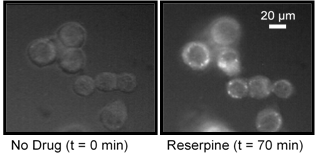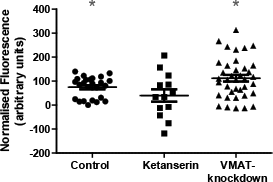Reserpine As A Fluorescent Probe For Catecholaminergic Vesicles Recent years have seen the development of fluorescent compounds able to functionally monitor the plasma membrane monoamine transporters (1). However, using analogous approaches to monitor vesicular monoamine transporters (VMATs) has been limited by specificity issues, particularly due to mitochondrial partitioning (2). We recently reported that reserpine, or a metabolite, is fluorescent and can be used to identify vesicular uptake in a catecholaminergic cell line (PC12 cells) (3); however, whether or not such sequestration requires VMAT was not established. PC12 cells, superfused with 10 μM reserpine and excited with 365 nm wavelength light, demonstrated a time-dependent increase in fluorescence of a punctate nature (Fig. 1), where puncta were of dimensions comparable to those of the large dense-core vesicles found in PC12 cells. Interestingly, pre-treating cells with another VMAT inhibitor, ketanserin (20 μM), was unable to inhibit the response to reserpine (P = 0.22, Welch’s unpaired t-test, Npuncta = 13, n = 3; Fig. 2). To further confirm VMAT1 specificity, PC12 cells were exposed to SLC18A1 siRNA (Silencer Select siRNA; Life technologies; cat. no. 4390771) to reduce VMAT1 expression – which was confirmed with qPCR (63 ± 6% VMAT1 mRNA reduction; n = 3). Surprisingly, punctate fluorescence in VMAT1 knockdown PC12 cells was significantly (1.5-fold) brighter than controls (*P = 0.025, Welch’s unpaired t-test, Npuncta = 38, n = 5; Fig. 2). Spectral analysis of reserpine-treated PC12 cells (with an Olympus Fluoview confocal microscope) suggested that the vesicles contained a trapped reserpine metabolite. We speculate that VMAT1 knockdown reduces H+ shunting, further acidifying vesicles thus increasing metabolite trapping.
Fig. 1 Reserpine-induced fluorescence in PC12 cells
‡Fig. 2 Reserpine-induced punctate fluorescence in: control, ketanserin-treated and VMAT-knockdown PC12 cell In summary, reserpine acts as an intravital fluorescent probe for vesicles. Such intravesicular reserpine accumulation may contribute to reserpine’s efficacy by causing neurotransmitter displacement in addition to the archetypal VMAT blockade. (1) Parker et al. (2010). Br J Pharmacol 159:797-807. (2) Berstein AI et al. (2014). Neurochem Int 73: 89-97. (3) van Gemeren et al. (2011). Proceedings of the British Pharmacological Society at: http://www.pA2online.org/abstracts/Vol9Issue3abst109P.pdf.
|



